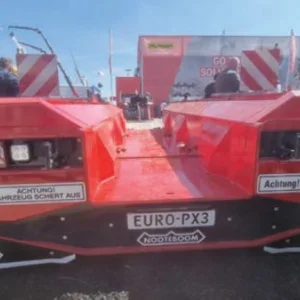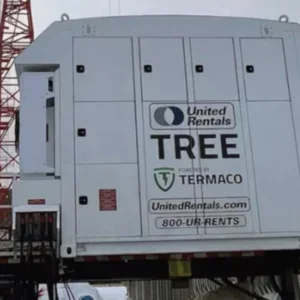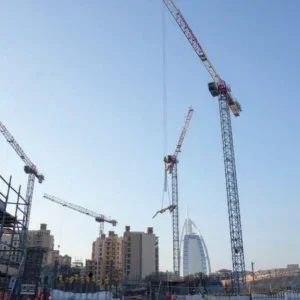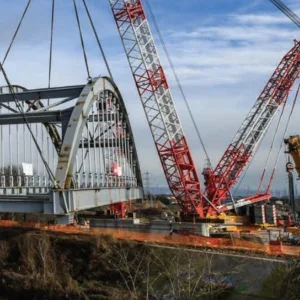The results of a tower crane collapse, especially in the confined space of a city construction site, can be catastrophic. That makes a new report on stability from a UK construction research organisation essential reading for every enlightened tower crane operator.
Tower Crane Stability, published by the UK CIRIA (the Construction Industry Research and Information Association), is intended to promote the safe design of tower crane foundations.
It is primarily aimed at designers of temporary works involving tower cranes. However, it is also intended to help groups requiring an understanding of the issues and be educated in the safe use of tower cranes – planners, architects, permanent works engineers and site supervisors.
With around 1,500 cranes in the UK (and 1,000 in use at any one time), tower cranes have the potential to cause death and destruction on a frightening scale.
The document identifies the main causes of tower crane failure and critical hazards. It also highlights key situations in which a specialist should be consulted, and explains the features of the most common tower cranes that should be taken into account when planning crane use early in a project.
Other parts of the 100-page document include temporary works elements including the design of foundations and use of structural ties, and the ways in which tower cranes apply particular loads to these elements; wind effects; other loading and support considerations; and factors of safety.
The project was supported by CIRIA itself, as well as the UK Government’s Department of Trade and Industry, the Health and Safety Executive, and HTC Plant.
But why produce the report? One of its authors, Hilary Skinner, explains: “There were a number of new standards – a lot of documents and initiatives that were out in the industry and relevant to tower cranes. There was, however, awareness in the industry that there was no single document [about tower crane stability] to which people could refer.
“I am a geotechnical engineer so I came at it from the idea of the foundations that would be required for tower cranes. While that was a major part of the report, part of it was focused on other issues to promote the safe design and use of tower cranes.
“We realised that everybody on site from the planner, architect and client all the way through to the temporary works engineer had to understand the important issues that related to maintaining tower crane stability.”
www.ciria.org
One of the authors of Tower Crane Stability is crane consultant Tim Watson, who revealed details at the TCIG meeting of a second publication he has been involved with – the revision of BS7121 Part 5. This 90-page document is due to be published this month.
The current version of BS7121 was published in 1997. However, as Watson explains, it is not standalone: “At the time [the current version] was written, the idea was that people should read all the parts together. The current document is fairly short – about 18 pages – and it has many references to clauses in other parts of BS7121. The idea was to make the revision a standalone document – you just need to but Part 5, and you have all the information in it you need to operate a tower crane.”
There was also little consideration of the important tasks of erection and climbing – a couple of paragraphs in the current version compared to around 10 pages in the revision, says Watson.
The new standard covers the recommendations for the safe installation and use of tower cranes including self-erectors (although these are only addressed briefly, and it envisaged that a full treatment will be given in a future publication). Subjects covered include selection, planning, installation, erection, extension (which includes climbing), thorough examination (which includes testing), maintenance, operations, dismantling, safety measures, and the selection and training of personnel.
One section of the document covers the management of installation and lifting operations. Watson explains: “We have used three categories of lift – basic lifts (where you know the weight of the load and there are no hazards or structures); standard lifts (where there are hazards present); and complex lifts, (which contain exceptional hazards such as a petrochemical plant, a complex load, say, with an unusual shape, and this section also includes the lifting of persons).”
Another section deals with planning lifting operations when the crane is in use. Watson again: “This is different from the planning that takes place when you are installing the crane. The operation should be planned (which is fairly obvious, but sometimes you wonder!), and should be carried out by an appointed person who has appropriate knowledge for the lifting undertaken.”
This section also covers risk assessment, which considers hazards likely to arise during a lifting operation, and examines what the control measures are needed to mitigate those hazards), and method statements (basically writing down the outcomes of the planning.
The document goes on to cover the selection and duties of personnel in some detail. It examines the duties of the appointed person, crane supervisor, crane co-ordinator, crane operator, slinger, signaller, and maintenance personnel. It also defines the duties of erection personnel including the crane erection supervisor, senior erector, erector and trainees erector and sets out attributes and duties for all those people.
Other sections deal with training; tower crane selection (on the basis of types of tower, jib, base, and crane); and safety (as Watson puts it: “Basically a ragbag section that collects together all those bits that are important, but don’t fit anywhere else”).
The safety section is broken down into personal safety equipment (including PPE and fall arrest systems), access to the emergency escape; fire extinguishers; limiting and indicating devices; electrical installation; lightning protection; ballast; documentation (including manuals, inspection reports, examination reports, and daily check sheets); and operators’ working hours and resources (including a chart that gives a recommendation of the number of operators required for the continual single shift operation of tower cranes).
Other sections of BS7121 Part 5 include:
* The siting of cranes, including the crane standing or support conditions.
* Proximity hazards such as low flying aircraft, railway lines, rivers, and motorways.
* Ground conditions.
* Tower crane foundations.
* Erecting, dismantling, and altering the crane’s height, including inspection before erection – As Watson says: “How often do you find that you are half way through an erection and something is missing or damaged? The classic is a cracked window – easy to repair on the ground, very often almost impossible once it’s up in the air.”
* Tower crane climbing.
* Procedures and precautions, including reporting defects and incidents, and leaving the crane unattended.
* Operating conditions, including rated capacity, mode of operation and control, and multiple lifting.
* Slinging and handling loads, including the weight and centre of gravity of the load, and signalling systems.
* Maintenance.
* Thorough examinations including the need for personal fall protection systems
Called to account
Following a serious incident at one of its sites, developer Bovis Lend Lease conducted an audit of tower cranes operating on its sites. The results were shocking, but the industry responded positively
In November 2004 Bovis Lend Lease suffered a fatality involving a tower crane on a project in the United States. The company’s group safety manager went to New York and came back with several suggestions, one of which was that it should conduct an audit of its tower crane policies in the UK.
Ian Wallace, safety manager at Bovis Lend Lease, explains: “Between February and March 2005, the company looked at 33 tower cranes across the UK; some sites had a single tower crane, others had several – a mixture of luffers, saddle cranes, and flat tops.”
The company was keen to find answers to a series of important questions. For example, says Watson, it wanted to know:
* Why did the tower crane erectors leave bins on platforms, lengths of timber on the jibs, and empty cans of grease lying around on the crane?
* Why did some raise and lower materials in plastic shopping bags?
* Why was machinery left unguarded?
* Why was there an improperly laid hoist rope?
* Why were materials stored at high level in containers that included cut down 5-gallon drums, orange baskets, and plastic shopping bags?
* Where were the training and records relating safety harnesses?
Other problems identified included:
* Gaps between fixed ladders where tower crane sections met.
* A lack of lightning protection.
* The standard of duty boards was low.
* Mixed crane components – for example, a mast of one make, and a jib of another.
* Weather monitoring – As Wallace asks: “Do we need indicators on every crane? If so, where – in the cab, at ground level?”
* Gaps in cab level steel decking.
* Condition of operators’ cabs – Wallace again: “One driver’s cab was pristine. Others were dirty and had broken windscreens or wiper blades.”
* Access to crane base – Wallace asks: “Do you really want your crane drivers to climb through an assault course to gain access to the crane cab? That is effectively what many had to do.”
* Anti collision systems were often switched off.
* High-level illuminated signs.
* High-level rescue – how do you get a crane driver or maintenance person down from a crane without incident?
* Fire extinguishers – some cranes had them, others did not.
* Poor risk assessments.
* A lack of pre-erection inspections.
Bovis Lend Lease presented its findings to individual tower crane companies in May/June last year, followed by a presentation to the UK Tower Crane Interest Group (TCIG) in August.
The industry responded through the TCIG. Consultant Tim Watson, who was responsible for co-ordinating the response, explains: “We decided that it would be better to give an industry response rather than each individual supplier trying to answer the questions. The industry decided that the TCIG should co-ordinate the response and we set up a working group to consider all the issues raised by the audit report.”
The outcome was the response presented to Bovis Lend Lease in January this year:
Access to tower cranes after commissioning: Says Watson: “The premise was that the tower crane was like any working platform on site so it ought to be in a state whereby anybody could just wander up and down at will. We felt that this was not correct.”
In fact, he says, a tower crane is a place of controlled access. “We felt that it should be controlled, and that there were two categories of people who required access – those needing frequent access such as the operator, supervisor, and maintenance personnel, and those requiring infrequent access such as management, the hirer’s personnel, or an HSE inspector, and that you would treat the people in different ways.”
The TCIG’s suggestion, therefore, was that a single person appointed by the principal contractor and approved by the crane owner, should control access. Says Watson: “The idea is that they would issue permits to all the people that need access to the crane so that you know who is going up, when, and what training they have had. In other words, you are only sending people up who are either competent themselves or are accompanied by somebody who is competent.”
Raising and lowering tools and small materials: The TCIG has produced a technical information note or “TIN” (see the box) that recommends a chest-mounted rucksack for light items, and a block and pulley system for heavier items.
Unguarded machinery: Watkins says that if you control access to the crane, you don’t need to provide guarding of the hoist rope, hoist drum and so on because they are safe by position. By controlling access, he says: “You are making sure that you don’t let people out onto the back jib unless it is in a safe condition.”
Improperly laid hoist rope: This, says Watson, was a one-off event and the supplier concerned has since bought equipment that will allow it to tension rope properly when it is put it onto drums. The TCIG has also issued guidance on installing wire ropes and their storage (TIN 004) – see the box.
Storage of materials at high level: This is a perennial problem with tower cranes – where do you place grease cartridges and spares, for example? The TCIG has suggested that a weatherproof box be installed at the top of the crane so that the driver and maintenance people can store small quantities of material neatly on top of the crane rather than just leaving it lying around.
Safety harnesses for operators: The TCIG’s insists that the operator should not need a safety harness because, in most cranes, he or she does not have to go out onto the crane on a regular basis.
Watson adds: “However, if operators do have to do this because of the design of the crane then they should be provided with an appropriate fall arrest system which they have been trained to use. Crucially, some means of rescue must be available if a fall should occur.”
Fixed ladders: Te TCIG has produced a technical information note, which demands that the ladders are fixed correctly, and that the question of hoops is addressed properly. Watson explains: “There is a misnomer that you must have hoops on all ladders. However, the EN standard on crane access says that this is not the case providing the structure gives an equivalent level of protection.”
Lightning protection: This is addressed in the revised British Standard BS7121 part 5.
Duty boards: These are covered in TIN 007, which explains where they should be fitted, and what condition they should be in.
Mixed crane components: The TCIG advises that, if you must use mixed crane components, you must ensure that one of the manufacturers agrees to it ,and gives you permission in writing to use that particular combination of one manufacturer’s components with another’s.
Weather monitoring: This is covered in detail in BS7121 part 5.
Gaps in decking: The TCIG has produced a technical information note, which sets out the minimum requirements for edge protection on tower cranes.
Pre-erection checks: These, says Watson, are crucial. Echoing Wallace’s point, he asks: “Why put a damaged component up in the air where it gets a thousand times more difficult to deal with that on the ground?” The TCIG has produced guidance (TIN 14) on these.
Access to the crane base: For Watson, crane base access should be made secure if the principal contractor requires this. He adds: “What we are saying is that the ‘garden shed’ around the base is not a good idea because it means you can’t inspect the base properly. A better idea is a proper fan fitted some way up the mast with a trap door. We are also keen that, if there is a locked trap door access point at the fan level, the operator must have instant access from the top and that there is a lock system that enables somebody below to get up to the operator if there is an emergency.”
Anti-collision systems: Watson emphasises that these are a secondary aid. He explains: “The primary responsibility for avoidance lies with the driver. If you feel you need an anti-collision system you need to understand what you are getting, give plenty of time for the supplier to install it, and ensure that everybody on the site understands the light system. The worst thing is having a system that people believe is working, but which is not. Also, bear in mind that the systems need a degree of maintenance.”
Illuminated signs and floodlights: If you use these, says Watson, they must be fixed securely to the crane, but as he points out: “If they are fixed, how do you maintain them – change bulbs and so on?”
As for signs and Christmas decorations, Watson prefers not to install them on cranes: “Signs and decorations can alter the wind loading, the ability of the crane to weather vane, and foundation loads, so it is important to consult the crane manufacturer if you are considering installing them.”
Rescue from height: The TCIG has a separate working group on this, which was formed before the Bovis report emerged. Watson explains: “We split the rescue from height up into two areas. One is for the erection crew while the crane is being built. That is quite simple because a lot of tower crane suppliers now use the ‘Gotcha’ system and they have people in the erection team trained in this system.
“The real problem is the rescue of people carrying out maintenance and the operators. We have set up legal requirements for doing it, who is responsible for doing it, and a basic regime for planning it. We haven’t come up with specific solutions because it is difficult to define a one size fits all solution. Every crane configuration is different.”
TCIG also conducted a survey on all the rescues that have been carried out on operators over the last 10 years. Watson again: “In fact we found only one. We took the number of operating hours over that period, and we worked out an incident rate – one incident in 12.9 million working hours. It may be that we are worrying about the wrong thing.”
Fire extinguishers: The TCIG is generally against putting these in cabs because the risk of asphyxiation in such an enclosed space outweighs the potential usefulness of fire extinguishers in this situation.
Risk assessments: The TCIG has put together a generic risk assessment covering general access to tower cranes and including emergency access. It may not fit every situation but you can use it as a basis for your particular situation and modify it accordingly.






